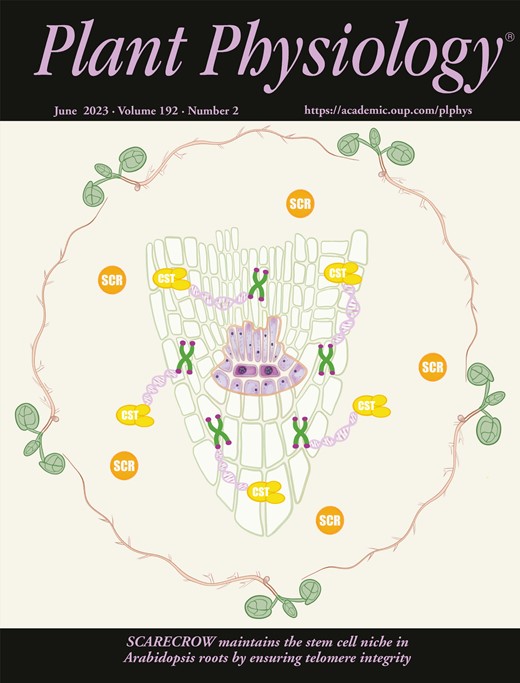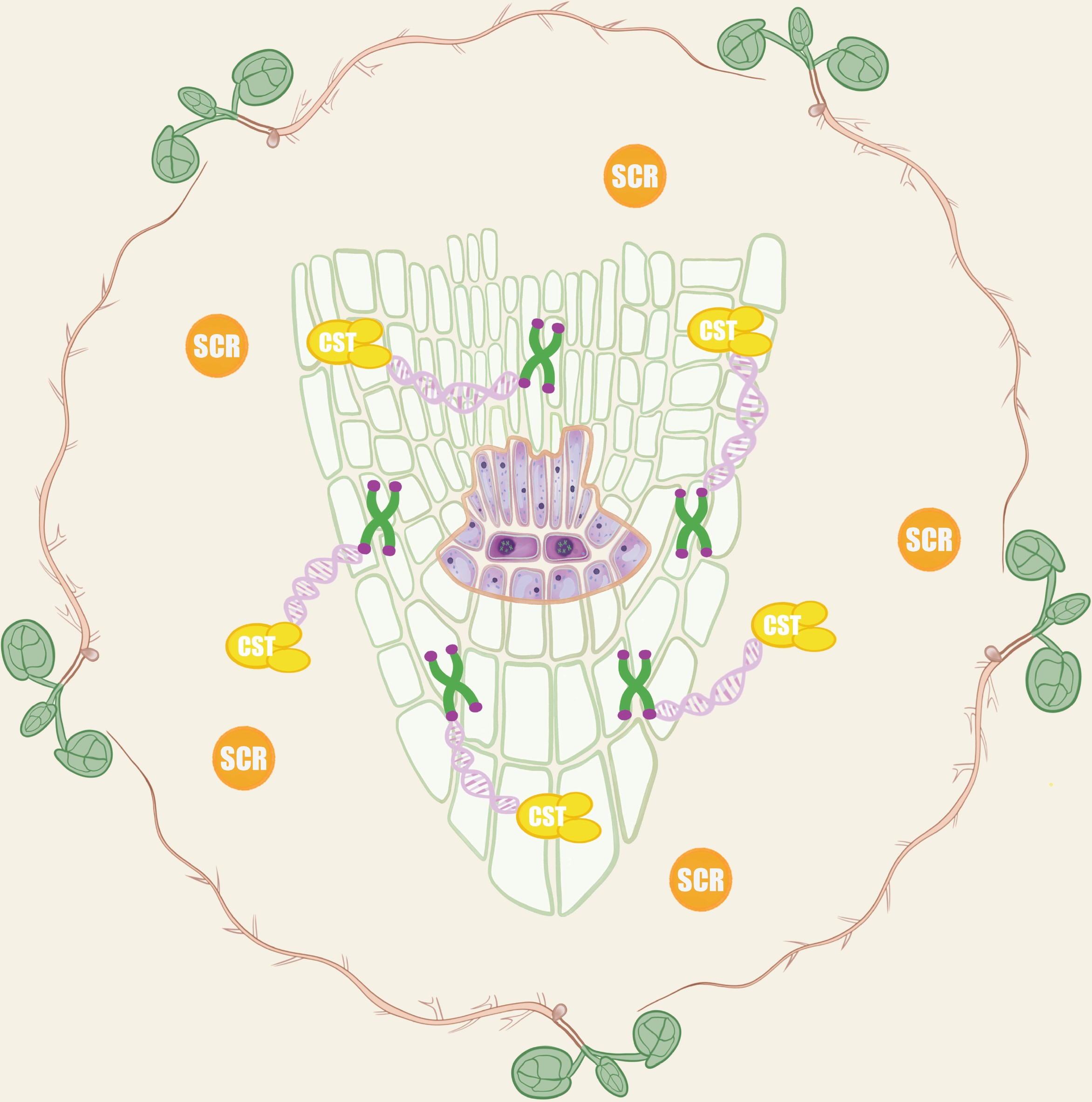
Cover image

Volume 192, Issue 2, June 2023
News and Views
Welcome to the TRIBE: An approach to identify RNA ligands of RNA-binding proteins in rice
Partners in crime: MicroRNA408 and peptide miPEP408 negatively regulate arsenic and low sulfur tolerance
Slits in the wall! Pulvinar slits confer unique cell wall mechanics for leaf movement
EngineeRING the gear of ATP synthase: a way to address complexity and flexibility of photosynthesis
Is hypoxia good or bad? Role of oxygen levels in maize kernel development
The mystery behind dark-orange tomatoes: How can an exotic cleavage dioxygenase alter carotenoid flux?
Am-aza-ing antidiabetic: Mulberry dehydrogenase MnGUTB1 contributes to the biosynthesis of 1-deoxynojirimycin
The bud awakens: Interplay among hormones and sugar controls bud release
Something seedy going on: HEAT SHOCK PROTEIN90.6 links carbon and nitrogen metabolism in seed development
Who does not LYKe fungi? A plant receptor modulates defenses to facilitate the establishment of fungal symbioses
Update
Ecophysiology and Sustainability
It's only natural: Plant respiration in unmanaged systems
Plant respiration varies in natural ecosystems—across leaves, stems, roots, and the whole organism—creating global patterns in respiration across species, ecosystems, and biomes.
Membranes, Transport, and Bioenergetics
The biogenesis and regulation of the plant oxidative phosphorylation system
Letter
Genes and Development
WUS-RELATED HOMEOBOX 14 boosts de novo plant shoot regeneration
Research Report
Signaling and Response
Differential transpiration between pods and leaves during stress combination in soybean
Differential transpiration between pods and leaves of soybean plants subjected to a combination of water deficit and heat stress buffers internal pod temperature.
Research Articles
Biochemistry, Biophysics, and Structural Biology
HDR, the last enzyme in the MEP pathway, differently regulates isoprenoid biosynthesis in two woody plants
Isoprenoid biosynthesis in woody plants with a distinct profile of isoprenoid compounds is regulated by the ratio of the precursors isopentenyl diphosphate and dimethylallyl diphosphate.
Restricting electron flow at cytochrome b6f when downstream electron acceptors are severely limited
When electron acceptors associated with carbon metabolism become limiting, Chlamydomonas activates a reversible restriction at the cytochrome b6f complex that helps avoid photodamage.
Breakthrough Technologies, Tools and Resources
Genome-wide profiling of rice Double-stranded RNA-Binding Protein 1–associated RNAs by targeted RNA editing
Targeted RNA editing identifies rice DOUBLE-STRANDED RNA BINDING PROTEIN 1-associated RNAs in vivo with high efficiency and accuracy.
Reliable genotyping of recombinant genomes using a robust hidden Markov model
Genotyping by low-coverage whole-genome DNA sequencing is improved by a hidden Markov model that imposes an optimal minimum length constraint on genomic segments.
Cell Biology
microRNA408 and its encoded peptide regulate sulfur assimilation and arsenic stress response in Arabidopsis
microRNA408 and microRNA408-encoded peptide regulate sulfur assimilation and arsenic stress responses in Arabidopsis.
Pulvinar slits: Cellulose-deficient and de-methyl-esterified pectin-rich structures in a legume motor cell
Unique structures in the primary cell wall, “pulvinar slits,” are discovered in a legume motor cell and findings suggest their role in repetitive and reversible deformation during leaf movement.
Two isoforms of Arabidopsis protoporphyrinogen oxidase localize in different plastidal membranes
The second isoform of protoporphyrinogen oxidase localizes in Arabidopsis exclusively to the plastid envelope membrane resulting in a spatial separation of both isoforms within the same organelle.
Autophagy and multivesicular body pathways cooperate to protect sulfur assimilation and chloroplast functions
Autophagy and the multivesicular body pathway regulated by LYST-INTERACTING PROTEIN 5 cooperatively protect crucial chloroplast functions under normal growth conditions to promote growth and fitness.
Plasma membrane-associated calcium signaling regulates arsenate tolerance in Arabidopsis
The calcium-dependent protein kinase CPK23 regulates the subcellular localization of the plasma membrane As(V)/Pi transporter PHT1;1 via phosphorylation to enhance arsenate tolerance in Arabidopsis.
Structural and functional regulation of Chlamydomonas lysosome-related organelles during environmental changes
The structure and function of Chlamydomonas lysosome-related organelles are regulated in response to environmental changes.
Genes and Development
Strigolactones positively regulate Verticillium wilt resistance in cotton via crosstalk with other hormones
Strigolactones enhance cotton resistance to Verticillium wilt through crosstalk with other hormones signaling pathways, and regulate hormones homeostasis through a negative feedback loop.
Armadillo repeat only protein GS10 negatively regulates brassinosteroid signaling to control rice grain size
A protein with six tandem armadillo repeats and unknown function is negatively involved in brassinosteroid signaling and in regulating grain size and grain quality in rice.
Kiwifruit bZIP transcription factor AcePosF21 elicits ascorbic acid biosynthesis during cold stress
A kiwifruit bZIP transcription factor promotes L-ascorbic acid biosynthesis to alleviate oxidative damage during cold stress.
cis-Golgi phosphate transporters harboring an EXS domain are essential for plant growth and development
Import of nucleotide diphosphate–sugars into Golgi is balanced by phosphate export mediated by ERD1, a protein broadly conserved in plants and essential for optimal growth and development.
A cryptic natural variant allele of BYPASS2 suppresses the bypass1 mutant phenotype
Regulation of capsule spine formation in castor
PagUNE12 encodes a basic helix-loop-helix transcription factor that regulates the development of secondary vascular tissue in poplar
The PagUNE12 transcription factor regulates secondary growth in poplar vascular tissue by promoting secondary stem cell wall thickening and lignin accumulation.
The transcribed centromeric gene OsMRPL15 is essential for pollen development in rice
Tomato sucrose transporter SlSUT4 participates in flowering regulation by modulating gibberellin biosynthesis
Transcription factors GmERF1 and GmWRKY6 synergistically regulate low phosphorus tolerance in soybean
A phosphate starvation response mechanism mediated by GmERF1 and GmWRKY6 regulates low phosphorus tolerance in soybean.
SCARECROW maintains the stem cell niche in Arabidopsis roots by ensuring telomere integrity
SCARECROW plays a role in maintaining the expression of factors protecting telomere ends, revealing a connection between genome integrity and stem-cell maintenance in Arabidopsis roots.
MEDIATOR SUBUNIT 16 negatively regulates rice immunity by modulating PATHOGENESIS RELATED 3 activity
OsMED16 negatively regulates cell death and immunity in rice, probably via the OsPR3-mediated chitin signaling pathway
Repressive ZINC FINGER OF ARABIDOPSIS THALIANA proteins promote programmed cell death in the Arabidopsis columella root cap
Paralog editing tunes rice stomatal density to maintain photosynthesis and improve drought tolerance
Knockout of EPIDERMAL PATTERNING FACTOR-LIKE10, a paralog of STOMAGEN, reduces stomatal density in rice without concomitant reductions in stomatal conductance, carbon assimilation, or thermoregulation.
Genomics and Evolution
Phylogenetic analyses of seven protein families refine the evolution of small RNA pathways in green plants
Inhibition of invasive plant Mikania micrantha rapid growth by host-specific rust (Puccinia spegazzinii)
Host-specific rust infection promotes JA accumulation not only to inhibit synthesis of the defense hormone SA, but also to affect the growth hormone, carbon, and nitrogen metabolism in Mikania micrantha.
Membranes, Transport, and Bioenergetics
Impact of engineering the ATP synthase rotor ring on photosynthesis in tobacco chloroplasts
Transplastomic tobacco plants with the c15-ring in the chloroplast ATP synthase maintain the normal photosynthetic growth by increasing the magnitude of proton motive force.
Exploring the potential of Δ17O in CO2 for determining mesophyll conductance
Expression of the wheat multipathogen resistance hexose transporter Lr67res is associated with anion fluxes
A wheat gene which confers partial resistance to multiple fungal diseases was found to be associated with increased ion transport that may contribute to disease resistance.
Metabolism
Causes and consequences of endogenous hypoxia on growth and metabolism of developing maize kernels
The developing maize endosperm has evolved elaborate structural, molecular, and biochemical mechanisms for acclimation to hypoxia.
Natural overexpression of CAROTENOID CLEAVAGE DIOXYGENASE 4 in tomato alters carotenoid flux
CAROTENOID CLEAVAGE DIOXYGENASE 4b cleaves ζ-carotene and β-carotene, and its overexpression leads to β-cyclocitral deficiency in tomato fruit.
Dehydrogenase MnGutB1 catalyzes 1-deoxynojirimycin biosynthesis in mulberry
Magnesium promotes tea plant growth via enhanced glutamine synthetase-mediated nitrogen assimilation
Magnesium transcriptionally regulates the glutamine synthetase gene CsGS1.1 during the enhanced assimilation of nitrogen in tea plants.
A dolabralexin-deficient mutant provides insight into specialized diterpenoid metabolism in maize
Analysis of companion cell and phloem metabolism using a transcriptome-guided model of Arabidopsis metabolism
The transcription factor CmERFI-2 represses CmMYB44 expression to increase sucrose levels in oriental melon fruit
An ethylene response factor derepresses expression of ethylene and sucrose synthesis genes to improve sucrose accumulation during oriental melon fruit ripening.
Sufficient coumarin accumulation improves apple resistance to Cytospora mali under high-potassium status
Increasing K content to high K status strengthens apple resistance to Cytospora mali through activating basal resistance events, especially leading to sufficient accumulation of coumarin in vivo.
Signaling and Response
Auxin-independent effects of apical dominance induce changes in phytohormones correlated with bud outgrowth
LysM receptor-like kinases involved in immunity perceive lipo-chitooligosaccharides in mycotrophic plants
A group of LysM receptor-like kinases known to modulate plant defense is also involved in establishment of arbuscular mycorrhiza in plant species able to establish the latter symbiosis.
FAR-RED INSENSITIVE 219 and phytochrome B corepress shade avoidance via modulating nuclear speckle formation
The crosstalk between light signaling and jasmonate levels is critical in regulating seedling development in Arabidopsis.
m6A mRNA modification promotes chilling tolerance and modulates gene translation efficiency in Arabidopsis
m6A modification modulates gene translation efficiency in the cold response and is important for sustaining Arabidopsis growth under chilling conditions.
AaSEPALLATA1 integrates jasmonate and light-regulated glandular secretory trichome initiation in Artemisia annua
A MADS-box transcription factor induced by jasmonate and light signaling positively regulates glandular secretory trichome initiation in Artemisia annua.
PP2C.D phosphatase SAL1 positively regulates aluminum resistance via restriction of aluminum uptake in rice
The plasma membrane (PM)–localized PP2C.D phosphatase SAL1 inhibits PM H+-ATPase to regulate NRAT1 transporter-mediated Al uptake and Al resistance in rice.
Altered expression of SELF-PRUNING disrupts homeostasis and facilitates signal delivery to meristems
Arabidopsis ACT DOMAIN REPEAT9 represses glucose signaling pathways
The ACT DOMAIN REPEAT9 protein acts upstream of a master regulatory module to repress the glucose signaling in early seedling development.
MEDIATOR SUBUNIT17 is required for transcriptional optimization of root system architecture in Arabidopsis
Mediator subunit MED17 regulates root system architecture by establishing a link between auxin and sucrose signaling pathways.
MicroRNA408 negatively regulates salt tolerance by affecting secondary cell wall development in maize
MicroRNA408 negatively regulates salt tolerance by affecting the expression of a laccase gene in maize.
Phytochromes mediate germination inhibition under red, far-red, and white light in Aethionema arabicum
Characterization of a phytochrome chromophore biosynthesis mutant demonstrates an active role of phytochromes in light-inhibited seed germination in Aethionema arabicum.
PECTIN METHYLESTERASE INHIBITOR18 functions in stomatal dynamics and stomatal dimension
PECTIN METHYLESTERASE INHIBITOR18 is involved in stomatal dynamics through participation in pectin methylesterification and distribution in guard cell walls.
Calcium-binding protein OsANN1 regulates rice blast disease resistance by inactivating jasmonic acid signaling
An OsANN1-HAN1 module maintains the balance between plant growth and blast disease resistance via regulating the jasmonic acid metabolic process in rice.
The microRNA ppe-miR393 mediates auxin-induced peach fruit softening by promoting ethylene production
The microRNA ppe-miR393 mediates auxin-induced fruit softening in peach by upregulating ethylene synthesis via post-transcriptional regulation.























































